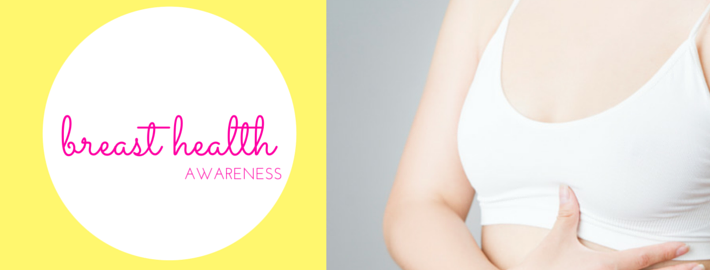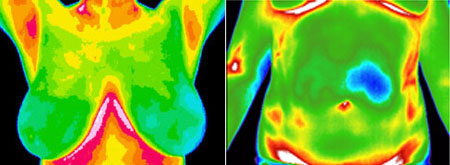10 Lifestyle Choices for Breast Health
We have joined forces with so many others by changing our attitude from “Breast Cancer Awareness” to “Breast Health Awareness”. Prevention is key and we must be vigilant in living healthy lifestyles that promote optimal health. The good news is that the majority of breast health practices are also practices that contribute to good health in general and to longevity. Research has concluded that only 10% of breast cancers are hereditary and the other 90% are caused by environmental factors. Take charge of your breast health by creating a healthy environment for your body and by making good lifestyle choices.
We have put together ten lifestyle choices to create breast health.
1. Avoid Wearing a Tight Fitting Bra, Avoid Wearing an Underwire Bra
Many women wear bras that fit wrong and that are too tight. Tight fitting bras prevent proper lymph drainage which prevent the removal of toxins from the breast tissue. A tight fitting bra literally cuts off the lymph circulation. The lymphatic system is a vital part of the immune system. It helps the body to get rid of toxins, waste and unwanted materials by draining it into the lymph fluid which is then carried away by the lymph system. In addition the lymph fluid contains white blood cells that protect the body from infection. To give an example, if you are wearing antiperspirants that contains aluminum and your body tries to drain the toxins out through the lymph fluid, aluminum potentially can start accumulating if it cannot be removed because lymph flow is disrupted by a tight bra. You want to ensure that your bra allows for the lymph fluid in your breasts to flow freely to be drained by the lymph nodes in the breast and under the armpits.
Michael Schachter M.D., F.A.C.A.M writes in his article, Integrative Medicine: The Prevention and Complementary Treatment of Breast Cancer:
Over 85 percent of the lymph fluid flowing from the breast drains to the armpit lymph nodes. Most of the rest drains to the nodes along the breast bone. Bras and other external tight clothing can impede flow. The nature of the bra, the tightness, and the length of time worn, will all influence the degree of blockage of lymphatic drainage. Thus, wearing a bra might contribute to the development of breast cancer as a result of cutting off lymphatic drainage, so that toxic chemicals are trapped in the breast.¹
Underwire bras on the other hand present a couple of its own problems to breast health. If you have ever been to an acupuncturist or Chinese medicine doctor they may have taped small metal balls (small magnetic patches known as AcuAids) over a particular acupuncture point to let you receive prolonged stimulation to that particular point.
In the same way metal from underwire bras stimulate pressure points that are located beneath the breasts. Below the breasts are two important neuro-lymphatic reflex points and metal from underwire bras is constantly activating these points. The neuro-lymphatic reflex point underneath the right breast is connected to the liver and gallbladder while the neuro-lymphatic reflex point underneath the left breast is connected to the stomach.
Doctor John D. Andre, D.C., N.D, explains the repercussions of this mechanism in his article, Dangers of Underwire Bras:
These reflexes, like all acupuncture points, follow the Law of Stimulation. In the beginning of stimulating a point, it is stimulated – often causing an increase in associated function. Later on, this continued stimulation causes sedation of that point and a subsequent decrease in its associated function. It’s a mechanical thing.
If a woman keeps the metal underwires on top of those reflex points, over time that WILL mess up the functioning of the associated circuits: Liver, gallbladder, and stomach.
Bottom Line: It will likely make her sick; slowly and quietly.²
The second problem with an underwire is the conducting aspect of the metal and that it can serve as a receptor and antenna for electromagnetic waves like the signals from cell phones, wi-fi, cordless phones and smart meters. We do not want to magnify electromagnetic waves right at our breast tissue. If you are still not convinced that EMFs cause cancer and pose a major public health risk, then see this plea by more than 190 scientists earlier this year.
On May 11, 2015, over 190 scientists from 38 nations submitted an appeal to the United Nations, the World Health Organization (WHO), and UN member states, requesting they adopt more protective guidelines for exposure to electromagnetic fields and wireless technology, based on increasing evidence of risk. The scientists who have signed the Appeal have published more than 2000 peer-reviewed research papers on the health effects of EMFs.
Heading the Appeal, Martin Blank, PhD, of Columbia University, states, “International exposure guidelines for EMFs must be strengthened to reflect the reality of their impact on our bodies, especially on our DNA. The time to deal with the harmful biological and health effects is long overdue. We must reduce exposure by establishing more protective guidelines.³
What Can You Do?
We recommend that you get a bra fitting and get rid of all tight fitting bras. Next start doing lymphatic drainage massage in the shower daily. See the video below for instructions. You can also try essential oil for the massage (see resources at end of article). If you want to wear wired bras, replace the metal with plastic wires. If you search for this online you will find many resources for that, or try your local sewing and fabric store. Avoid wearing a bra for longer than 12 hours per day.
How to do a lymphatic breast massage4
For those women who would consider not wearing a bra at all, in the table below is a summary of the results from a study done by Sydney Ross Singer and Soma Grismaijer (a husband-and-wife medical anthropology team). The study included 4,000 women and concluded that wearing a bra increases a woman’s risk for developing breast cancer. This study also showed that women with cysts in their breasts experienced marked improvement when they stopped wearing bras.5 This study is controversial and the The American Cancer Society states that it did not take into account known risk factors for breast cancer. For example, overweight and obesity. Women who opt to go braless probably have smaller breasts and are most likely thinner than woman who wear bras. Nevertheless, this is interesting data and certainly worth considering when making a personal decision about what type of bra to wear and how long to wear it every day. Do your own research and empower yourself to make good choices.
- Bra Wearing Time
- 24 hours per day
- More than 12 hours/day and not to bed
- Less than 12 hours/day
- Rarely
- Breast Cancer Risk
- 3 out of 4
- 1 out of 7
- 1 out of 52
- 1 out of 168
2. Be Conscious of Your Diet
Pay attention to your diet and eat a whole foods (non-processed), only organic and non-GMO diet with lots of fresh vegetables. Avoid known allergenic foods like dairy, wheat and soy. Pesticides and herbicides and chemicals contained in food are fat soluble and love our fatty breasts. Read about eating organic here. Include plenty of vegetables in your diet and a large amount of green vegetables. Let at least 50% of your food be raw (uncooked). This is the proper way to hydrate and clean our cells.
3. Limit Alcohol Consumption to One Drink Every Once In a While
The more alcohol you drink the more you increase your chances of developing breast cancer. Research has shown that two drinks a day could increase breast cancer risk by 21%. Alcohol stimulates the production of estrogen and an increased lifetime exposure to estrogen increases the risk of breast cancer.
4. Abstain from Smoking or Quit Smoking Now
Studies show a link between smoking and breast cancer. If you are thinking about quitting smoking, you will find this article helpful: Steps to Stop Smoking.
5. Avoid Environmental Pollution and Toxins
It is extremely important to live a lifestyle that avoids environmental toxins and that provides the body with support to clean these toxins from the body. Exhaust fumes from gasoline in particular is bad for breast health.
Environmental toxins are present in breast milk6 as well as in the blood of unborn fetuses. The accumulation of these toxins in the human body is undeniable, particularly the so-called Persistent Bioaccumulative Toxins (PBTs). The United States Environmental Protection Agency writes the following on their website in regards to the Toxics Release Inventory Program, “These PBT chemicals are of particular concern not only because they are toxic but also because they remain in the environment for long periods of time, are not readily destroyed, and build up or accumulate in body tissue.”7
Some environmental toxins like DDT and other chlorinated compounds accumulate in the body because of their fat-soluble nature. Other compounds do not stay long in the body, but still cause toxic effects during the time they are present. For serious health problems to arise, exposure to these rapidly-clearing compounds must occur on a daily basis. Read further about toxins here.
There are 188 air toxics listed as hazardous air pollutants (HAPs) in the Clean Air Act (CAA), based on their potential to adversely impact public health.8
As we can see we live in a world where we are surrounded by toxins and chemicals. Many of which we do not have much control over. However, we can stop purchasing consumer goods that contain chemicals and toxins. We can also demand that manufacturers make products that will not give us cancer. This requires letting go of many things we would normally use or buy, however one quickly realizes that it is easy to get along without these items. Household cleaning products, make-up and personal care products are great shopping categories to start voting with your dollar.
6. Avoid Xenoestrogens Derived from Synthetic Chemicals
The balance between the two classes of female sex hormones, estrogen and progesterone is very important. The body tends to balance these two hormones naturally. Prolonged excessive estrogen or progesterone deficiency (estrogen dominance) has a direct correlation to a woman’s risk of developing breast cancer.
Xenoestrogens are foreign (“xeno”) substances that mimic estrogen’s action in the body. Xenoestrogens can either be natural chemical compounds or synthetic. These chemicals are foreign hormones to the body that produce the same effects as estrogen. The increasing number of synthetic xenoestrogens in our environment have been linked to breast cancer.9 Some enhance the production of the so-called bad estrogens while others bind to estrogen receptors which unnecessarily signals the receptors to increase cellular growth.
Natural xenoestrogens include phytoestrogens which come from plants and exposure to these natural phytoestrogens are usually by eating them and are sometimes called “dietary estrogens”. This exposure is minimal and do not have the same disrupting effect as synthetic xenoestrogens.
Synthetic xenoestrogens are also known as Endocrine Disruptor Chemicals (EDC’s) because of their impact on the endocrine (hormone) systems of the body.
Some examples of synthetic xenoestrogens are –
- Bisphenol A (BPA) – plastic bottles, sports equipment, CDs, DVDs, water pipe linings, coatings in many food and beverage cans, thermal paper as in sales receipts
- PCBs
- Phthalates (plasticizers) added to plastics to increase their flexibility, phytransparency, durabality
- Nonylphenols (industrial surfactants and pesticides)
- Astrazine (weedkiller)
- Pesticides and Insecticides
- Parabens (personal care products)
- Bovine growth hormone in commercial diary
- Birth Control Pills
It is important to avoid the accumulation of synthetic xenoestrogens in the body over time. You can minimize your exposure to xenoestrogens by avoiding:
- pesticides and insecticides by eating organic only
- eating food from plastic and styrofoam containers
- storing food in plastic containers
- reheating foods in plastic and styrofoam containers
- drinking canned drinks
- drinking water from plastic bottles
- dairy especially commercially farmed dairy that contains bovine growth hormone
- parabens found in moisturizers and hair care products
7. Maintain a Healthy Weight Especially After Menopause
Overweight and obesity increase your chances of breast cancer. Obesity is also a well-known risk factor for breast cancer recurrence and poor prognosis.
8. Have an Active Lifestyle
An active lifestyle means being outside, moving your body and getting some sun! You do not have to join a gym to have an active lifestyle, but you can of course if that is your preference. Take up gardening or hiking with a group in your area or go for solitude walks in nature. The key here is moving our bodies and preferably in the sunshine. This is the best way to make vitamin D. Vitamin D is essential to prevent all cancers. Wearing sunscreen will repel UVA and UVB rays. The only wavelength that will have your body make vitamin D are UVB-rays when they shine directly on the skin (bare arms and legs). Moving the body is key to stimulate lymph flow and for the immune system. Remember this is different than just exercise. Exercise is great and important but an active lifestyle is about doing activities as part of your life that involves moving your body and being exposed to the sun a few times a week. This will also reduce stress and create a state of relaxation.
9. Avoid Menopausal Hormone Replacement Therapy
Avoid menopausal hormone replacement therapy (HRT) even bio-identical hormones. HRT has been linked to an increase of breast cancer in many studies and bio-identical hormones have not been studied yet.
10. Avoid Unnecessary Radiation from Medical Diagnostic Procedures
Examples of diagnostic procedures that expose us to radiation are CT scans, Chest X-Rays, and Mammograms. These procedures have been linked to an increase in breast cancer. Thermal imaging is an alternative to mammography for breast screening. Thermal imaging can also be used as an adjunct screening to mammography. A thermal image can show changes in breast tissue long before a mammogram can. These changes are tracked by measuring inflammation in the breasts as well as angiogenesis. Angiogenesis is the growth of new blood vessels. Tumors grow their own blood supply to feed them. Both inflammation and angiogenesis will result in higher infrared reading by an infrared camera. A woman who’s thermal image shows ‘hot’ areas can then choose to take action by making aggressive lifestyle changes to address the changes that are observed. Regular thermal follow-up screenings (every 3-6 months) can then be scheduled to compare further changes in the breast tissue. Thermography uses infrared heat cameras to capture an image of a particular area of the body. To find out more about about thermal imaging, please visit our traveling thermographer, Lisa Kalison of Discovery Screening’s website.
In January 2013, the Swiss medical board was mandated to conduct a study on mammography screening. The report was published in 2014. The results showed that mammography screening might prevent about one death out of one thousand women screened. The harm of mammography screening lies in false positive tests and over-diagnosis. “For one breast cancer death prevented in the US, women over a 10 year course of annual screening beginning at 50 years of age, 490 to 670 women are likely to have a false positive mammogram with repeat examination and 70 to 100 an unnecessary biopsy10”. The recommendation of the board was that no new mammography screening would be introduced at that time and to place a time limit on the existing programs.
Doctor Maya Nicole Baylac, N,D. shared the following about her personal and professional mammogram experiences:
I got one mammogram in my life, around the age of 50 after being subjected to pressure from a friend. The experience scared me so much to have my breast squeezed between two metal plates that I did not do it ever again. I am glad that this information about the harm caused by mammography is now released at a time where doctors are put in jail for giving treatments to women who did not ever have cancer.
From asking my patients how they discovered their cancers, I never heard anyone say that it was from a mammogram. Instead, most found their cancer from self-examination. This shows the need for us to be responsible for our health in any ways possible. Prevention is the key for breast cancer as it is for all chronic illness. Reversing cancer is possible but more difficult.
We recommend you do regular self-examinations on your breasts. We also recommend that you find a thermographer in your area. This is not necessarily to replace mammograms if you feel comfortable with this screening method, but thermography can be used either as an adjunct or stand-alone screening method. It will show increased blood flow and inflammation in the breast long before a mammogram will pick up a tumor. Mammograms can see a growth when it is about the size of a nickel. Earliest detectable age by mammogram is after eight to ten years of cancer cell growth. Thermal imaging can detect metabolic indicators for cell changes as early as three years from first abnormal cell development. Thermal screening is about prevention and making lifestyle changes. We recommend that you educate yourself on recent changes in breast screening recommendations and make your own judgement about screening your breasts. Do not blindly follow your gynecologist or doctor’s recommendation without debate and discussion.
REFERENCES:
- Integrative Medicine: The Prevention and Complementary Treatment of Breast Cancer, Michael Schachter M.D., F.A.C.A.M.,
http://www.healthy.net/Health/Article/The_Prevention_and_Complementary_Treatment_of_Breast_Cancer/533/4 - Relfe.com, Dangers of Underwire Bras, John D. Andre, D.C., N.D., http://www.relfe.com/wp/health/dangers-underwire-bras/
- http://www.earthcalm.com/scientists-appeal-to-un-for-more-protective-emf-guidelines
- http://www.breasthealthproject.com/lymphatic-breast-massage.html
- Dressed to Kill, 1995, Sydney Ross Singer, Soma Grismaijer, http://www.selfstudycenter.org/dressedtokill.htm
- Tidsskr Nor Laegeforen. 2009 Dec 17;129(24):2606-9. doi: 10.4045/tidsskr.09.0696
- Fact Sheet on EPCRA Section 313 Rulemaking. Persistent Bioaccumulative Toxic Chemicals http://www2.epa.gov/sites/production/files/documents/pbtrule-fs.pdf
- J Air Waste Manag Assoc. 2004 Feb;54(2):157-71.
- Fernandez and Russo, Estrogen and Xenoestrogen in Breast Cancer, Toxicol Pathol 2010: 38(1); 110-122
- N England J Med 2014; 370:1965-1967
RESOURCES:
- Discovery Screening’s Lisa Kalison travels to The Big Island bi-annualy to do thermal screenings on the island. Please visit her website if you would like to set up an appointment for the next time they will be on island.
- Thermography information is available on Discovery Screening’s website, go here.
- Essential Oil formula that can be used during a lymphatic drainage massage: Healthy Girls Breast Oil. Get info here.










